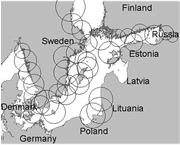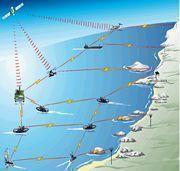Press release
HELCOM launches a common Baltic maritime traffic monitoring system
 Helsinki, 1 July (HELCOM) – The Helsinki Commission today officially launched an Automatic Identification System (AIS) for monitoring maritime traffic in the Baltic Sea. It is an automatic VHF radio-based system which enables the identification of the name, position, course, speed, draught and cargo of every ship of more than 300 gross tonnes sailing in the Baltic Sea, and displays all available data over a common background map of the region.
Helsinki, 1 July (HELCOM) – The Helsinki Commission today officially launched an Automatic Identification System (AIS) for monitoring maritime traffic in the Baltic Sea. It is an automatic VHF radio-based system which enables the identification of the name, position, course, speed, draught and cargo of every ship of more than 300 gross tonnes sailing in the Baltic Sea, and displays all available data over a common background map of the region.
“The system is fully operational today and covers the whole Baltic Sea area and Norway,” said Anne Christine Brusendorff, HELCOM Executive Secretary. “It will greatly improve risk management and facilitate decisions on new measures to prevent collisions and improve navigational safety in the Baltic Sea”.
The system consists of land-based stations established in all the coastal countries to receive ship-borne information as the vessels pass through national waters, and a so-called "HELCOM server", which combines all the data and provides a comprehensive real-time picture of the overall vessel traffic in the Baltic Sea to the competent authorities in each HELCOM member state. The server updates ship positions every six minutes.
In addition to providing shore stations with information, the AIS also enables ships to detect and identify each other at sea. The AIS messages contain information on the identity, position and course of the vessel, as well as different additional data.
The primary task of the shore-based AIS network is to provide competent authorities with a monitoring tool for supervision, statistics, risk analyses, search and rescue (SAR), port state control, security and other safety related tasks to ensure safe navigation in the crowded waters of the Baltic Sea.

The HELCOM AIS network will make it possible to not only monitor maritime traffic but also to elaborate statistics on the nature and extent of shipping as well as the amount of cargo being transported in the Baltic Sea area. Thus it will also provide the basis for future risk assessments and identification of needs for additional measures.
"Implementing the Automatic Identification System was a challenging and demanding task for all the HELCOM countries, but we met the deadline of 1st of July 2005, as defined in the Copenhagen Declaration", said Benny Pettersson, Chairman of the AIS Expert Working Group.
The decision to establish a land-based monitoring system for ships, based on AIS signals, was agreed during the HELCOM Extraordinary Ministerial Meeting in Copenhagen in 2001, which followed one of the gravest recent oil spill incidents in the Baltic Sea when on 29th of March 2001, close to the sea border between Germany and Denmark, the double hull oil tanker “Baltic Carrier” collided with the bulk carrier “Tern”, releasing 2700 tons of heavy fuel oil from the cargo tanks of which a significant part eventually washed up onto parts of the Danish coast.
This system builds upon the International Maritime Organisations (IMO) requirements for ships to be equipped with AIS. Together with the establishment of land-based stations which are able to receive AIS data the Baltic Sea States are now able to gather information on ship traffic in the Baltic. This HELCOM work will also give valuable input at European level to the implementation of the EU directive on traffic monitoring and information under which an AIS exchange system shall be operational by the end of 2008.
----------------------------------------------------------------
Background: Maritime traffic in the Baltic Sea
The issue of maritime safety is a high priority within the Baltic Sea region. The Baltic is a relatively small sea, with many rocky shallows, narrow straits and labyrinthine archipelagos, as well as harsh winter ice conditions. The Baltic Sea is criss-crossed by some of the busiest shipping lanes in the world. The intensity of shipping activities in the Baltic has been growing very rapidly during the last decade, and there is no sign of this process slowing down. There are around 2,000 ships at sea at any time, accounting for 15 % of the world’s cargo transportation. All kinds of cargo are being shipped in and out of the Baltic Sea countries, including oil and hazardous substances. Everyday 150-200 large tankers are filled with oil in 20 ports around the Baltic.
Not only has the number of ships increased, but also their size: today some ships in the Baltic carry as much as 100,000 tons of oil. As the sizes of the ships increase, the risk of a major oil spill also increases. Every year about 70 shipping accidents occur in the Baltic Sea. Fortunately most of them do not cause notable pollution, but even one large-scale accident would seriously threaten the Baltic marine environment.
Forecasts predict a further 40 % increase in oil transportation by 2015 from today’s level of more than 160 million tonnes a year. Economic factors favour the use of maximum size tankers (able to carry 100,000-150,000 tonnes of oil), as the cost per tonne of transported oil can be reduced considerably by using large tankers.
Contacts
HELCOM Secretariat
Mr Tadas Navickas
Professional Secretary
Tel: +358 9 6220 2242
Fax: +358 9 6220 2239
Mr Nikolay Vlasov
Information Secretary
Tel: +358 9 6220 2235
Fax: +358 9 6220 2239

